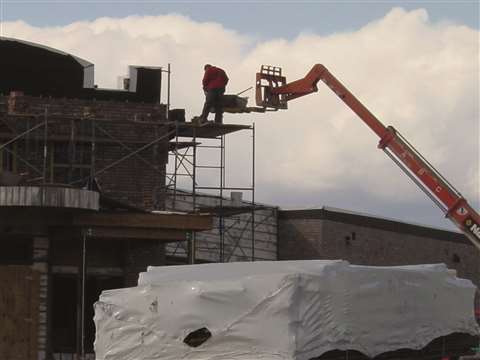Hanging loose – or not
18 October 2022
Fall protection for workers on elevated platforms have been promoted for over a century, as the historic National Safety Council safety warning (see NSC graphic) demonstrates.
 An older ad from the National Safety Council on fall protection. (Graphic: David Glabe/NSC)
An older ad from the National Safety Council on fall protection. (Graphic: David Glabe/NSC)
Even after almost 50 years in the access industry, I find the subject of fall protection to be, if nothing else, bewildering. And it’s not that I don’t understand the subject, but rather that I don’t understand all the confusion, false information, inconsistent regulatory enforcement, non-complying work processes, and in some cases, plain lack of knowledge.
It is quite obvious that fall protection is necessary when working at heights. It should also be obvious that gravity is involved in the act of falling. One would think then that physics would dictate the regulations that would dictate worker behavior. The reality of the situation is that the matter of fall protection is multi-faceted and not necessarily fact-based.
The science behind falls
The physics of a fall are undisputed, particularly since the force of gravity has been reasonably stable for quite some time. Here is how it works: you choose to jump off a mobile elevating work platform (MEWP) platform from 30 feet. Surprisingly you fall down instead of up, due to gravity. As you fall, you accelerate, due to gravity. The force with which you will hit the level below is based on your initial speed, the distance you fall, and here is the important stuff, how quick you come to a stop, and how far you travel while coming to a stop.
Since you chose to jump off the MEWP platform, hopefully you also chose the surface upon which you will land. If its concrete, you are going to stop quickly; if you chose marshmallows, you’ll be in better shape. In other words, choose the marshmallows.
Regulations are based on the science of falling. For example, the OSHA regulations require that the force on your body can be no more than 1,800 pounds. This limits your free fall. The regulations address anchor strength, again based on the applicable physics. To decrease the load on your body, and the anchor, the industry has employed the use of retractable lanyards and shock-absorbing lanyards, which coincidentally allows workers to comply with the regulations.
It is interesting to note that since the regulations are based on the science of physics, they don’t necessarily reflect industry practice. And here is where it gets bewildering. While the regulations make sense, based on the physics, they don’t necessarily make sense when applied to actual work practices.
OSHA and fall protection
For example, back in 1994 when the current OSHA fall protection regulations were promulgated, the scaffold industry was up in arms, claiming that there was no way that erectors could comply with the regulations. And, in many instances, it was, and still is, true. Erectors asked how they could limit a free fall to 6 feet when the only anchor was at their feet? How could erectors tie off to a scaffold frame which was not rated for the required 5,000 pounds? For that matter, who rates the anchor? That question brings us to the next issue.
 In 1994, the scaffold industry claimed there was no way erectors could comply with OSHA’s newly implemented fall protection regulations. (Photo: David Glabe)
In 1994, the scaffold industry claimed there was no way erectors could comply with OSHA’s newly implemented fall protection regulations. (Photo: David Glabe)
The OSHA regulations specify that fall protection anchors shall support 5,000 pounds or be designed by a Qualified Person. If experience is any indicator, rare is the occasion when a worker connects to an anchor that is actually rated for 5,000 pounds. In fact, other than purpose-built anchors for users of such things as suspended scaffolds, workers connect to what they estimate to be a 5,000-pound anchor.
Without analysis, any estimate is purely a guess. Luck is with the typical worker, however. First, the worker rarely falls so the anchor is never tested. Second, it looks good that the worker is tied off, so everyone is satisfied. Third, OSHA is delighted the worker is utilizing fall protection and therefore doesn’t give the anchor much thought. And fourth, everyone thinks their fall protection, and anchor, are working and consequently they declare success. The “Look Good” hypothesis is accepted without proof. Custom and practice is the accepted norm; that is, nobody really complies with the regulations addressing fall distance, anchor strength, deceleration distance, force on the body, or physics. Apparently, that is okay since the typical force on the anchor is a lot less than 5,000 pounds and again, people get lucky.
MEWPs
Speaking of regulations, MEWPs present an example of bewildering regulations. Self-propelled elevating work platforms, a member of the mobile elevating work platform family of products, and known as scissor lifts, have been determined by OSHA to be a scaffold, not a MEWP.
 OSHA regulations are based on the science of physics, however, as seen here, they don’t necessarily reflect industry practices. (Photo: David Glabe)
OSHA regulations are based on the science of physics, however, as seen here, they don’t necessarily reflect industry practices. (Photo: David Glabe)
Therefore, the OSHA scaffold regulations addressing fall protection apply to scissor lifts. A careful reading of the fall protection regulations in OSHA 29 CFR 1926.451(g)(1) reveals that once the platform is more than 10 feet above the level below either a guardrail system or a personal fall protection system is permissible. This would mean that if you never raise the platform above 10 feet, no fall protection is required. At 10 feet, you must select the fall protection you will be utilizing. Keep in mind that if you choose personal fall protection, it probably won’t work at or below 10 feet — you will hit the ground. But hey, you look good tied off.
Fortunately, scissor lifts typically always have a guardrail system so you don’t need a personal fall protection system. Too bad the custom and practice requires both systems be used and even some manufacturers require it. One laughable argument for the use of both systems is in response to those workers who decide to climb on top of the guardrail. Since you can’t fix stupid, we all pay the price.
So, there you have it. While the regulations are based on science, in many instances actual practice inhibits compliance. So, the default solution is to wear a harness, use a lanyard, either shock-absorbing or retractable, and connect it to something that looks really strong. You now have conformed with the custom and practice and more importantly, have met the requirements of the Look Good Hypothesis (LGH.) Just don’t fall.
STAY CONNECTED



Receive the information you need when you need it through our world-leading magazines, newsletters and daily briefings.
CONNECT WITH THE TEAM








